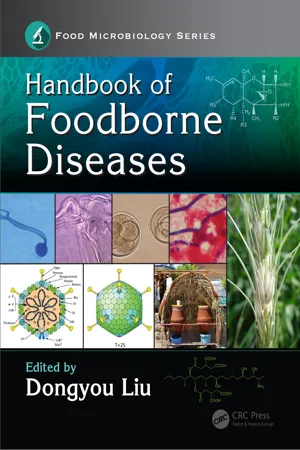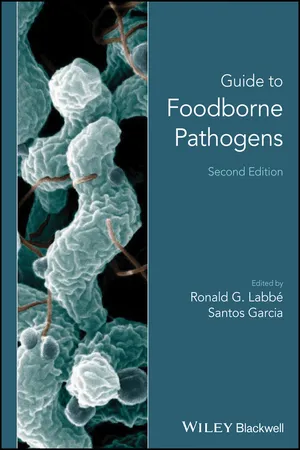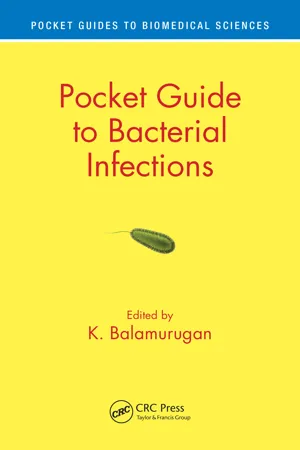Biological Sciences
E Coli
E. coli, short for Escherichia coli, is a type of bacteria commonly found in the intestines of humans and animals. While most strains are harmless, some can cause illness, such as diarrhea and urinary tract infections. E. coli is also widely used in biological research and biotechnology due to its well-studied genetics and ease of manipulation.
Written by Perlego with AI-assistance
Related key terms
5 Key excerpts on "E Coli"
- eBook - ePub
- Dongyou Liu(Author)
- 2018(Publication Date)
- CRC Press(Publisher)
30 Escherichia Marta Rivas, Elizabeth Miliwebsky, Beatriz D’Astek, and Luis PianciolaContents 30.1Introduction 30.2Classification 30.3Life Cycle 30.4Epidemiology30.1Introduction30.5Enteropathogenic E. coli30.5.1Epidemiology 30.5.2Clinical Features 30.5.3Pathogenesis 30.5.4Diagnosis 30.5.5Treatment 30.5.6Prevention30.6Shiga Toxin-Producing E. coli30.6.1Epidemiology 30.6.2Clinical Features 30.6.3Pathogenesis 30.6.4Diagnosis 30.6.5Treatment 30.6.6Prevention30.7Enteroaggregative E. coli30.7.1Epidemiology 30.7.2Clinical Features 30.7.3Pathogenesis 30.7.4Diagnosis 30.7.5Treatment 30.7.6Prevention30.8Enterotoxigenic E. coli30.8.1Epidemiology 30.8.2Clinical Features 30.8.3Pathogenesis 30.8.4Diagnosis 30.8.5Treatment 30.8.6Prevention30.9Enteroinvasive E. coli30.9.1Epidemiology 30.9.2Clinical Features 30.9.3Pathogenesis 30.9.4Diagnosis 30.9.5Treatment 30.9.6Prevention 30.10Conclusion and Future Perspectives ReferencesThe genus Escherichia is a member of the family Enterobacteriaceae ,1 and the species Escherichia coli as part of this genus, is widely distributed in nature. It was first described in 1885 by the German pediatrician Theodore von Escherich, who called it Bacterium coli .2 The taxonomical name of Escherichia coli was later adopted to honor its discoverer.30.2ClassificationEscherichia coli is a gram-negative, oxidase-negative, rod-shaped, facultative anaerobic bacillus with both fermentative and respiratory metabolisms, nonmotile or motile by peritrichous flagella. It is a major inhabitant of the large intestine of both humans and warm-blooded animals, and as part of the commensal microflora, maintains the physiological health of the host. Colonization begins at birth, but maturation of the microflora is a continuous process lasting for several years, and E. coli is one of the first facultative organisms to colonize the human gut.3 It is estimated that 1%–4% of all cultivable bacteria of the colon are E. coli bacteria, and up to 1010 CFU/g of feces can be detected.4 - eBook - ePub
- Karen C. Carroll, Michael A. Pfaller, Marie Louise Landry, Alexander J. McAdam, Robin Patel, Sandra S. Richter, David W. Warnock(Authors)
- 2019(Publication Date)
- ASM Press(Publisher)
E. coli, as most of them carry critical virulence genes on mobile genetic elements.Description of the Genus
The genus Escherichia is composed of motile or nonmotile bacteria that conform to the definitions of the family Enterobacteriaceae (1 , 2 ). Species in this genus are Gram-negative, oxidase-negative rods that grow well on MacConkey agar (MAC). When these organisms are motile, it is by peritrichous flagella. They can grow aerobically or anaerobically. All ferment D -glucose, and most produce gas from the fermentation of this substrate and other fermentable carbohydrates. Lactose is fermented by most strains of E. coli, but its fermentation may be delayed or absent in all or most strains of E. albertii, E. blattae, E. fergusonii, and E. vulneris. Typical phenotypic properties are listed in Table 1 .TABLE 1 Biochemical reactions of the six species of Escherichia and selected members of the family EnterobacteriaceaeaEpidemiology and Transmission
E. coli occurs naturally in the lower part of the intestines of humans and warm-blooded animals. In humans, it typically colonizes an infant’s gastrointestinal tract within hours of birth and subsequently becomes the predominant facultative anaerobe in the human colonic microbiota, where it exists in a mutually beneficial relationship with its host. E. coli generally remains confined to the intestinal lumen; however, in a debilitated or immunosuppressed host or when bacteria are introduced to other tissues following trauma or surgical procedures, even commensal, “nonpathogenic” strains of E. coli can cause infection. E. coli is typically transmitted through ingestion of contaminated food and water, person-to-person contact, contact with animals, or contact with environments or fomites contaminated with fecal material. Convincing evidence of respiratory transmission has not been reported. Most strains of E. coli do not cause disease in healthy persons; however, there are specific pathogenic groups, addressed below, whose members are capable of causing disease in humans and animals. The infectious dose for diarrheagenic E. coli varies by strain and pathotype and ranges from 10 to 100 bacteria for E. coli O157:H7 (24 ) to 108 or more bacteria for ETEC (25 - eBook - ePub
- Ronald G. Labbé, Santos García(Authors)
- 2013(Publication Date)
- Wiley-Blackwell(Publisher)
Escherichia coli Peter Feng U.S. Food and Drug Administration, College Park, Maryland, USA14.1 Introduction
Escherichia coli is a normal inhabitant of the digestive tract of animals, including humans. It serves many beneficial functions in the body by synthesizing useful vitamins and by competing and suppressing the growth of pathogenic bacteria that may be present or ingested with food and water. With the exception of anaerobic bacteria, E. coli is one of the dominant enteric species in the human feces; therefore, it has been used as an indicator of fecal contamination for close to a century. The concept of indicators is based on the premise that if E. coli is detected in food and water, it is evidence that the product has been fecal contaminated and that pathogens may also be present. However, as E. coli can be found in environmental sources, the use of E. coli as a fecal indicator has been challenged as being unreliable; but as no suitable substitute has been proposed, it continues to be used as an indicator of insanitation worldwide.E. coli is a member of the family Enterobacteriaceae and the genus is composed of Gram negative, aerobic, facultatively anaerobic, non-sporeforming rods. They have the ability to ferment a variety of sugars, but the fermentation of lactose with production of acid and gas is characteristic, as it is for other members of thE Coliform group. E. coli can be further classed into biotypes based on the IMViC tests (indole, methyl red, Voges-Proskauer, and citrate), where biotype I and II have + + - - and - + - - reactions, respectively. Since the majority of E. coli are indole positive, biotype I are much more prevalent. Other biochemical traits include ß-glucuronidase activity, but absence of urease, phenylalanine deaminase and H2 S production. Serological typing of E. coli - eBook - ePub
- K Balamurugan, Prithika Udayakumar(Authors)
- 2019(Publication Date)
- CRC Press(Publisher)
E. coli requires molecular methods for knowing the subtypes which are not routinely available and are restricted to reference laboratories. Hence, evaluating patients with diarrheal illness is cumbersome.Most of these illness are self-limiting lasting only for few days and do not require antibiotics. Only severe and complicated cases require antibiotics, and in fact in some cases, antibiotics might even be harmful as with EHEC. Bacteria developing resistance toward antibiotics makes it mandatory to know the sensitivity pattern before selecting an antibiotic. This makes the isolation of organism even more important. As mentioned before, there has also been a changing trend of bacteria with falling incidence of well-known older infections (i.e., EHEC O157, Vibrio cholerae) and increasing incidence of other organisms (i.e., Campylobacter, Yersinia) with few maintaining a constant trend (i.e., Salmonella), and finally with lots of emerging organisms (i.e., Arcobacteria, Edwardsiella tarda, Plesiomonas shigelloides, Aeromonas hydrophila, Listeria monocytogenes, and Laribacter hongkongensis). This chapter discusses the general biology and transmission means of more common and emerging bacterial pathogens causing GI infection and describes various diagnostic and treatment methods. The order of the pathogens represents their contribution toward disease severity.1.2 Escherichia coliE. coli is the foremost gram-negative facultative anaerobic bacilli residing in the intestines of humans and other mammals. Most of the strains remain harmless, but few cause mild to severe diarrheal illness. Six major types of E. coli based on their pathogenesis are ETEC, enteropathogenic E. coli (EPEC), enteroinvasive E. coli (EIEC), EHEC, or Shiga toxin producing E. coli (STEC), enteroaggregative E. coli (EAEC), and diffusely enteroadherent E. coli (DAEC). A comprehensive overview of these groups of E. coli is presented in Table 1.1 - eBook - ePub
The Embodied Mind
Understanding the Mysteries of Cellular Memory, Consciousness, and Our Bodies
- Thomas R. Verny(Author)
- 2021(Publication Date)
- Pegasus Books(Publisher)
enteric nervous system, the nervous system of the alimentary canal. Along this route exchange of information takes place in both directions.Bacteria
Typically, bacteria are shaped like spheres, rods (figure 5.1 ), or spirals. Escherichia coli, the bacteria responsible for fecal contamination in food is about 7 μm (7 microns) long and 1.8 μm in diameter. On the average there are 40 million bacterial cells in a gram of soil and one million bacterial cells in a milliliter of fresh water. There are approximately 5×1030 bacteria on earth, forming a biomass that exceeds that of all plants and animals combined.Once described as mere “bags of enzymes,” bacterial cells were long thought to have little to no internal structure. Bacteria, as opposed to single-celled organisms like the slime mold that we shall discuss shortly, do not have a membrane-bound nucleus, and their genetic material is typically a single circular DNA chromosome with its associated proteins and RNA located in the cytoplasm in an irregularly shaped body called the nucleoid (figure 5.2 ). Very recently, researchers at McGill University have discovered bacterial organelles involved in gene expression, suggesting that bacteria may not be as simple as once thought. In Eschericha coli, the bacteria that were the subjects of the McGill study, organelles are held together by “sticky” proteins rather than a membrane. Scientists refer to this system as phase separation. It may be a universal process in all cell types, and it may have been involved in the very origin of life on earth.Bacteria face a never-ending battle with viruses and invading strands of nucleic acid known as plasmids. To survive this onslaught, bacteria and archaea2 deploy a variety of defense mechanisms, including an adaptive-type immune system that revolves around a unit of DNA known as CRISPR, which stands for Clustered Regularly Interspaced Short Palindromic Repeats.The bacterial immune system also relies on an enzyme called Cas9 that uses immunological memories to guide cuts to viral genetic code. It seems that Cas9
Learn about this page
Index pages curate the most relevant extracts from our library of academic textbooks. They’ve been created using an in-house natural language model (NLM), each adding context and meaning to key research topics.




